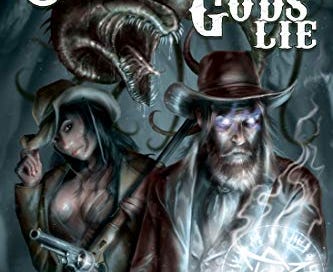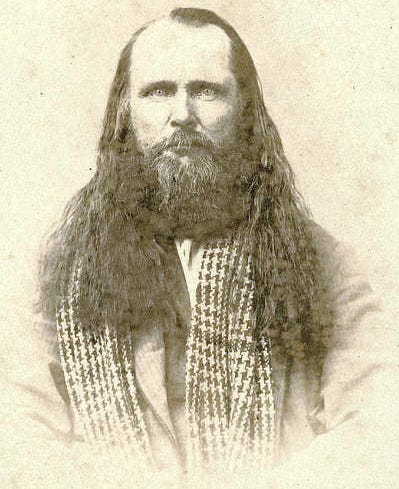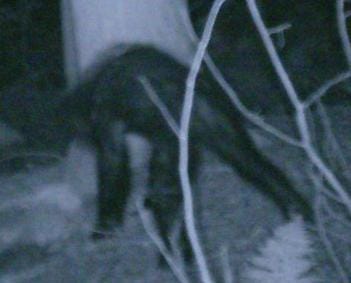Sparks, give me some western swing.
Western-swing, aye Cap’n!
I was thinking something a little less doomy, but this’ll do Sparks, this’ll do.
Louis L’Amour Meets Lovecraft
Porter Rockwell, wanted for a murder he did not commit, is hiding out in Old California selling whiskey to thirsty forty-niners. When his friends dig up some monstrous bones and a peculiar book and offer to sell it for a helluva price, Porter can’t resist the mystery.
But when both his night bartender and the sellers are murdered at his saloon Porter has to find out what the mysterious artifacts are all about. With some Native American legends, Sasquatch, Lovecraftian horror, and murderous bandits thrown in, not even bullets and blades can stop Rockwell from leaving a swath of righteous carnage in his wake.
Let Sleeping Gods Lie is a weird western fantasy in the vein of classic pulp fiction and Louis L’Amour books. If you like frontier justice, larger-than-life characters, and witty humor, then you will LOVE the first installment of the Cowboys and Cthulhu series.
Thus reads the promise made by the add copy, let’s crack the covers and find out if it’s made good, shall we?
First, I must make a confession my dear readers. While I am a Lovecraft and Derleth aficionado (and Lovecraft-only puritans, you know who you are, can fuck right off, Derleth, as the stubborn Catholic brought to the Mythos a moral heart and ethic that Lovecraft himself was searching for and could not find, yes, this is a hill I will die on) I am not much of Western reader.
I cannot recall reading a single Louis L’Amour, ever. Faerie Tales, Ghost Stories, Chansons, Romances of all kinds, Space Operas, Histories, Prose Poems, and Myths and Legends, yes - yes - yes and yes, but not a single Dime Novel of a Western bent that I can remember. I suppose I should have to say that my fascination is upon the Old World and also upon the Stars. As to why this should be so, well, I guess my hand just happened to fall onto it when I picked up this from my papa’s shelves instead of this. Twas a fate written in the stars.
But perhaps the stars are right to change that?
Speaking of stellar conjunctions, we may have signs and portents awaiting us within these covers. We are first introduced to our narrator, one Porter Rockwell. ‘Wait JD,’ I hear you say, ‘should we know who that is?’ Yes dearest readers, yes you should. At least if you have any Far Westron in ye, ye should.
I may not be well read up on my literary cow-tales, but I grew up with those stories. Heard them around camp fires. Orrin Porter Rockwell was The Avenging Angel of Brigham Young, and if you have ever lived in the Mormon World, then his name rivals those of Wyat, Doc, Bat, and Billy. According to his folk-legend, he even played host to Sir Francis Burton while he was in Salt Lake City in 1860, drinking the water of life late into the night, discussing Indian fighting and mountaineering and Lord knows what else interesting things. And of course, there’s the legend of his invincibility like that of Samson, as long as razor touches neither hair on head nor beard.
But in the world of ‘Sleeping Gods’ Porter is still firmly in his ‘mountain man’ and ‘wilderness scout’ phase and in the middle of the 1848-55 Gold Rush, he’s running a saloon for 49ers in California at a charming camp called ‘Muderer’s Bar’. Whiskey being a better and much more reliable living than panning and prospecting, and with the advantage of being safer too. But trouble has a way of following a man, whether he goes a lookin’ fer it or no.
When a clutch of Chinamen bring Porter a metallic tome of copper pages they have dug up, looking to turn it into quick cash, Porter, no stranger to strange books writ on strange plates found underground, is understandably ready to make a bid. But the strange book is stolen from his saloon and his nightwatchman and the Chinamen are found dead and a great mystery is afoot. A mystery that leads us to gangs of claim-jumpers, Red Indians, strange winged things better left buried, bigfoot, and blue-litten K’n-yan.
Through it all Porter is deft hand with street howitzer and Colt Dragoon - perhaps a little cutting edge and expensive for a mountain man in an 1849-ish, but as a successful business man he could have afforded it and what’s a Western without a six-gun? I mean a Patterson pattern or Walker might be more plausible, but I nitpick, for I am an ironmonger at heart. Less plausible is swapping preloaded cylinders to rapidly recharge any open frame colt, thanks to that pesky barrel wedge design. However it would work with a top-strap Remington of the era, so I guess we can forgive it due to the rule of cool, even if the New York reload is more historic like.
Along the way we have blood and thunder by the bucket-load and period picaresque escapades. What is most impressive is how restrained Mr. West is with the Mythos. We get hints here and there, rumour of ‘Old Ones’ and ancient things better left buried, and everyone, Chinaman or Red Indian, except poor Porter — who gets to play ‘stupid White man from town’ — knows that the ‘stars being right’ is bad feng shui, heap big bad medicine. But there’s hardly a squamous tentacle to be found in the whole piece, apart from the cover and the final set-piece.
I would have appreciated it if the Indian medicine man had a different, more localised name for the night-gaunts, but I will assume it’s a translation into the common tongue by Bloody Mary (Porter’s Indian side-kick and bad-ass sqwa) and instead credit the deft weaving of Sasquatch lore and Coyote into the Mythos, I’m sure my old web-fren Rainforest_Giant would appreciate it, wherever he be.
‘Well JD,’ I hear you asking, ‘is the promise delivered?’
Yes, yes it is. My only real criticism of the work is that the work is over all too quickly; too rapidly I have devour’d it, and I find it has left me hungry still and wanting more, the which I can hardly fault any writer for. Mayhap it be that I have an appetite for Westerns after all.
Especially Weird ones.
Nathicana
By H. P. Lovecraft
It was in the pale garden of Zaïs;
The mist-shrouded gardens of Zaïs,
Where blossoms the white nephalotë,
The redolent herald of midnight.
There slumber the still lakes of crystal,
And streamlets that flow without murm’ring;
Smooth streamlets from caverns of Kathos
Where brood the calm spirits of twilight.
And over the lakes and the streamlets
Are bridges of pure alabaster,
White bridges all cunningly carven
With figures of fairies and daemons.
Here glimmer strange suns and strange planets,
And strange is the crescent Banapis
That sets ’yond the ivy-grown ramparts
Where thickens the dust of the evening.
Here fall the white vapours of Yabon;
And here in the swirl of vapours
I saw the divine Nathicana;
The garlanded, white Nathicana;
The slender, black-hair’d Nathicana;
The sloe-ey’d, red-lipp’d Nathicana;
The silver-voic’d, sweet Nathicana;
The pale-rob’d, belov’d Nathicana.
And ever was she my belovèd,
From ages when Time was unfashion’d;
From days when the stars were not fashion’d
Nor any thing fashion’d but Yabon.
And here dwelt we ever and ever,
The innocent children of Zaïs,
At peace in the paths and the arbours,
White-crown’d with the blest nephalotë.
How oft would we float in the twilight
O’er flow’r-cover’d pastures and hillsides
All white with the lowly astalthon;
The lowly yet lovely astalthon,
And dream in a world made of dreaming
The dreams that are fairer than Aidenn;
Bright dreams that are truer than reason!
So dream’d and so lov’d we thro’ ages,
Till came the curs’d season of Dzannin;
The daemon-damn’d season of Dzannin;
When red shone the suns and the planets,
And red gleamed the crescent Banapis,
And red fell the vapours of Yabon.
Then redden’d the blossoms and streamlets
And lakes that lay under the bridges,
And even the calm alabaster
Glow’d pink with uncanny reflections
Till all the carv’d fairies and daemons
Leer’d redly from the backgrounds of shadow.
Now redden’d my vision, and madly
I strove to peer thro’ the dense curtain
And glimpse the divine Nathicana;
The pure, ever-pale Nathicana;
The lov’d, the unchang’d Nathicana.
But vortex on vortex of madness
Beclouded my labouring vision;
My damnable, reddening vision
That built a new world for my seeing;
A new world of redness and darkness,
A horrible coma call’d living.
So now in this coma call’d living
I view the bright phantons of beauty;
The false, hollow phantoms of beauty
That cloak all the evils of Dzannin.
I view them with infinite longing,
So like do they seem to my lov’d one;
So shapely and fair like my lov’d one;
Yet foul from their eyes shines their evil;
Their cruel and pitiless evil,
More evil than Thaphron and Latgoz,
Twice ill for its gorgeous concealment.
And only in slumbers of midnight
Appears the lost maid Nathicana,
The pallid, the pure Nathicana,
Who fades at the glance of the dreamer.
Again and again do I seek her;
I woo with deep draughts of Plathotis,
Deep draughts brew’d in wine of Astarte
And strengthen’d with tears of long weeping.
I yearn for the gardens of Zaïs;
The lovely lost garden of Zaïs
Where blossoms the white nephalotë,
The redolent herald of midnight.
The last potent draught I am brewing;
A draught that the daemons delight in;
A draught that will banish the redness;
The horrible coma call’d living.
Soon, soon, if I fail not in brewing,
The redness and madness will vanish,
And deep in the worm-peopled darkness
Will rot the base chains that hav bound me.
Once more shall the gardens of Zaïs
Dawn white on my long-tortur’d vision,
And there midst the vapours of Yabon
Will stand the divine Nathicana;
The deathless, restor’d Nathicana
Whose like is not met with in living.



![Let Sleeping Gods Lie: A Lovecraftian Gods Horror Story (Cowboys & Cthulhu Book 1) by [David J. West] Let Sleeping Gods Lie: A Lovecraftian Gods Horror Story (Cowboys & Cthulhu Book 1) by [David J. West]](https://substackcdn.com/image/fetch/$s_!9K8e!,w_1456,c_limit,f_auto,q_auto:good,fl_progressive:steep/https%3A%2F%2Fbucketeer-e05bbc84-baa3-437e-9518-adb32be77984.s3.amazonaws.com%2Fpublic%2Fimages%2F1f65ce29-8c0e-474e-a0a6-082fbb4de535_333x500.jpeg)




Mormon Supernaturalism Our Own Family History.
In April 1888, the Hales moved to Cache Valley, bringing their voluminous genealogical records with them, and began an extensive temple activity. At this time they arranged with Samuel Roskelley to prepare the sheets for temple work. He kept names in the temple continuously from then unto about 1903. That fall his health began to fail, his eye sight was poor, and he decided to give up all his record work. He brought the records to sacrament meeting one night and game them to Alma H. Hale, and told him it would be necessary to get some one else to take over the work. Jonathan H. Hale wrote: “During the following week, father was very depressed and worried all the time, and was hardly able to work or eat. He could not decide what to do, for neither he nor any of the Hale family knew how to proceed with the work. A great deal of information had been gathered and the family felt a great responsibility to complete the work. The whole family made it a matter of prayer for the week. The next Sunday at meeting, Brother Roskelley came to father and said: ’Bring the records back to me. I have to finish them. Friday evening as I was returning home from the temple, near Hyde Park, a messenger on a white horse appeared by the side of my buggy and said he wanted me to finish the Hale record. He assured me that the work was done right and that it was all being accepted. He said thousands of the Hale family were anxious that the work go on. I explained that I was too busy to do any more record work, and that my eyesight and health would not permit it. Then the messenger made me this promise, that if I would continue, the Lord would bless me with health and strength, my eyesight would be good, and the way would be opened so I would have the necessary time to do the work. He stayed by my side until I finally promised to do it, and then he blessed me and disappeared.’ ”When Brother Roskelley described this messenger to father, he answered, “Why that was my own father, Jonathan Harriam Hale, the first of the Hale’s to join the church in 1834. He died in 1847 at Winter Quarters.'” When Brother Roskelley finally finished the record he said that the greatest load he ever carried was lifted off his shoulders. He had made a promise to a heavenly being and couldn’t rest until the work was completed. He went home that very night and took off his glasses and never wore them again in his life. He enjoyed much better health and found more time for the work than he had hoped for. The Hale family had a week-long reunion in the temple about 1905, when they completed the last baptism and endowment, and then on Friday afternoon the last sealing was done for the 4,000 family members. As President Merrill neared Smithfield that night on his way to Richmond, he turned to tell the temple good-bye, as was his custom, and his heart about jumped out of his body. He could see the temple was on fire, but as he looked at it for a few minutes he was satisfied that there were no red flames licking upwards. The whole temple was filled with light, and the outside of the building shone with a pale pink glow. All the people in the neighborhood gathered to watch the phenomena and said they heard a heavenly choir sing for nearly two hours. Everyone marveled at the sight, for there were no electric lights or others means for lighting the building until ten years later in 1915. The same thing happened the following night, too, with all the rooms and the building lighted, and the heavenly choir singing. President Merrill knew that we had had a very heavenly manifestation. When he reported the incident to President Wilford Woodruff, the president asked what special work had been done in the temple. He was told of the unusual activity of the Hale family and how they had accomplished so much in such a little time. President Woodruff said the Hale and Boynton families had been permitted to come from the Other Side, to sing and rejoice and celebrate their deliverance in the Logan Temple. (Nolan P. Olsen, Logan Temple: The First 100 Years)
It's wonderful to see you make a connection to your own family heritage of early Mormonism.
Whatever was really going on in those days was genuine "high weirdness".